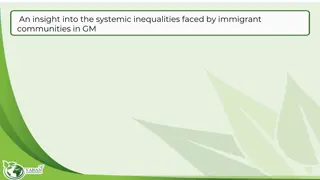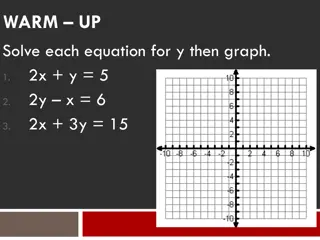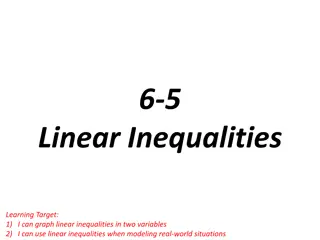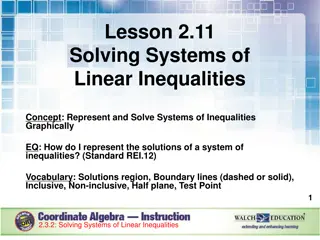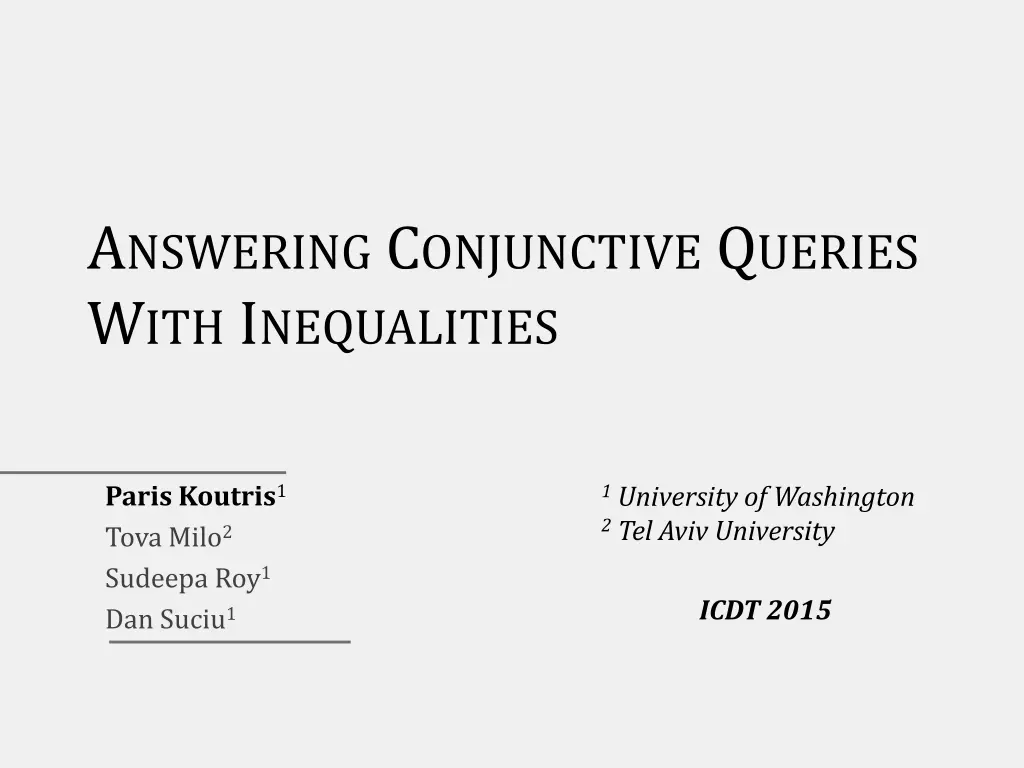
Combined Complexity of Conjunctive Queries with Inequalities
Explore the combined complexity of computing conjunctive queries with inequalities, delving into how the addition of inequalities impacts query evaluation. Discover techniques, examples, and contributions in the realm of query plans for inequalities, shedding light on the computational intricacies involved in such scenarios.
Download Presentation

Please find below an Image/Link to download the presentation.
The content on the website is provided AS IS for your information and personal use only. It may not be sold, licensed, or shared on other websites without obtaining consent from the author. If you encounter any issues during the download, it is possible that the publisher has removed the file from their server.
You are allowed to download the files provided on this website for personal or commercial use, subject to the condition that they are used lawfully. All files are the property of their respective owners.
The content on the website is provided AS IS for your information and personal use only. It may not be sold, licensed, or shared on other websites without obtaining consent from the author.
E N D
Presentation Transcript
ANSWERING CONJUNCTIVE QUERIES WITH INEQUALITIES Paris Koutris1 Tova Milo2 Sudeepa Roy1 Dan Suciu1 1 University of Washington 2 Tel Aviv University ICDT 2015
PROBLEM What is the combined complexity of computing conjunctive queries with inequalities (CQ )? query (q,I): q = R(x,y),S(y,z),T(z,w) I = {x z, y w} 2
EXAMPLE: PATH QUERY Path query (of length k) Pk = R1(x1,x2),R2(x2,x3), ,Rk(xk,xk+1) acyclic query polynomial combined complexity R1 R2 R3 Rk . . . x1 x2 x3 xk xk+1 3
EXAMPLE: PATH QUERY Path query + inequalities Pk = R1(x1,x2),R2(x2,x3), ,Rk(xk,xk+1) I = {xi xj,for all i<j} equivalent to Hamiltonian path NP-hard inequality graph R1 R2 R3 Rk . . . x1 x2 x3 xk xk+1 4
EXAMPLE: PATH QUERY Path query + inequalities Pk = R1(x1,x2),R2(x2,x3), ,Rk(xk,xk+1) I = {xi xi+2, for all i} polynomial combined complexity R1 R2 R3 Rk . . . x1 x2 x3 xk xk+1 5
CONTRIBUTION How does the combined complexity of computing CQs changes when we add inequalities? Given any blackbox algorithm that computes q, we can compute (q,I) with a g(q,I) log(|D|) blowup Given any Selection-Projection-Join plan that computes q, we can compute (q,I) with a f(q,I) blowup 6
OUTLINE Color Coding The Main Technique Query Plans for Inequalities 7
BACKGROUND [Papadimitriou, Yannakakis 97] Let q be a boolean acyclic CQ and D be a database instance. Then, q can be evaluated in time k = #variables in the inequality graph fixed-parameter tractability 8
COLOR CODING: IDEA [Alon, Yuster, Zwick 97] Pick a random coloring h: Dom {1, , k} maps values to k colors If a tuple t belongs in the answer of the full query, then the colors satisfy the inequalities with probability e-k tuple a b c d col #1 1 2 1 4 q = R(x,y),S(y,z),T(z,w) I = {x z, y w} col #2 1 2 3 3 valid 9
COLOR CODING: THEOREM /Theorem/ Let q be a CQthat can be computed in time T(|q|, |D|). Then, (q, I) can be computed in time Color-coding demands the construction of k-perfect hash family for every instance There is a log(|D|) additional factor The algorithm is oblivious to the combined structure of the query + inequalities 10
OUTLINE Color Coding The Main Technique Query Plans for Inequalities 11
MAIN TECHNIQUE q = R(x1, ,xm),S(y1, ,yl) + inequalities How do we compute (q,I) ? Cartesian product, then apply the inequalities time O(ml|R||S|) IDEA: compress R to a representation R of size independent of |R|, then compute the product R ,S 12
RUNNING EXAMPLE inequality graph (bipartite) H R(x1, x2) (1,1) (1,2) (1,4) (1,8) (2,3) (2,1) (3,2) (5,2) (2,2) (2,4) y1 x1 y2 x2 y3 13
H-ACCEPTED TUPLES A tuple t over the schema of S is H-accepted by R if for some t in R, t and t satisfy the inequalities in H y1 R(x1, x2) (1,1) (1,2) (1,4) (1,8) (2,3) (2,1) (3,2) (5,2) (2,2) (2,4) x1 y2 x2 y3 t = (2,1,3) is H-accepted t = (2,1,2) is not! 14
H-EQUIVALENCE Relations R1, R2 are H-equivalent if for any tuple t, t is H- accepted by R1 if and only if t is H-accepted by R2 /Lemma/ There exists a sub-instance R of R s.t. R ,R are H-equivalent |R | f(H), independent of R R can be computed in time O(f(H) |R|) 15
H-FORBIDDEN TUPLES A tuple t over Dom + {-} is H-forbidden for R if for every tuple t in R, the inequalities between t, t are violated R(x1, x2) (1,1) (1,2) (1,4) (1,8) (2,3) (2,1) (3,2) (5,2) (2,2) (2,4) t = (1,2,3) is H-forbidden t = (1,2,-) is also H-forbidden The H-forbidden tuples are infinitely many but the minimally H-forbidden are finite 16
THE ALGORITHM R(x1, x2) (1,1) (1,2) (1,4) (-,-,-) (1,8) (1,1) (2,3) (2,1) (1,-,-) (-,-,1) (3,2) (-,1,-) (5,2) (2,2) (2,4) 17
THE ALGORITHM R(x1, x2) (1,1) (1,2) (1,4) (-,-,-) (1,8) (1,1) (2,3) (2,1) (1,-,-) (-,-,1) (3,2) (-,1,-) (5,2) (1,2) (2,2) (2,4) (-,2,1) (1,-,1) (-,1,1) (1,-,-) remains H-forbidden (-,1,-) remains H-forbidden (-,-,1) is not 18
THE ALGORITHM R(x1, x2) (1,1) (1,2) (1,4) (-,-,-) (1,8) (1,1) (2,3) (2,1) (1,-,-) (-,-,1) (3,2) (-,1,-) (5,2) (1,2) (2,2) (2,4) (-,2,1) (1,-,1) (-,1,1) (1,4) only the rightmost node needs expansion (1,2,1) 19
THE ALGORITHM R(x1, x2) (1,1) (1,2) (1,4) (-,-,-) (1,8) (1,1) (2,3) (2,1) (1,-,-) (-,-,1) (3,2) (-,1,-) (5,2) (1,2) (2,2) (2,4) (-,2,1) (1,-,1) (-,1,1) (1,4) the tuple (1,8) expands no node (1,2,1) 20
THE ALGORITHM R(x1, x2) (1,1) (1,2) (1,4) (-,-,-) (1,8) (1,1) (2,3) (2,1) (1,-,-) (-,-,1) (3,2) (-,1,-) (2,3) (5,2) (1,2) (2,3) (2,2) (2,4) (-,2,1) (1,2,-) (1,-,3) (2,1,-) (-,1,3) (1,-,1) (-,1,1) (1,3,-) (2,3) (1,4) (2,3) (2,1,1) (1,3,1) (1,2,1) (1,2,1) 21
THE ALGORITHM R(x1, x2) (1,1) (1,2) (1,4) (-,-,-) (1,8) (1,1) (2,3) (2,1) (1,-,-) (-,-,1) (3,2) (-,1,-) (2,3) (5,2) (1,2) (2,3) (2,2) (2,4) (-,2,1) (1,2,-) (1,-,3) (2,1,-) (-,1,3) (1,-,1) (-,1,1) (1,3,-) (2,1) (2,3) (1,4) (2,1) (2,3) (1,2,3) (1,1,3) (2,1,1) (1,3,1) (1,3,1) (1,2,1) (1,2,1) 22
THE ALGORITHM R(x1, x2) (1,1) (1,2) (1,4) (-,-,-) (1,8) (1,1) (2,3) (2,1) (1,-,-) (-,-,1) (3,2) (-,1,-) (2,3) (5,2) (1,2) (2,3) (2,2) (2,4) (-,2,1) (1,2,-) (1,-,3) (2,1,-) (-,1,3) (1,-,1) (-,1,1) (1,3,-) (3,2) (2,1) (3,2) (2,3) (1,4) (2,1) (2,3) (3,1,3) (1,2,3) (1,1,3) (2,1,1) (1,3,1) (1,3,1) (2,1,2) (1,2,1) (1,2,1) (3,2) (3,2) the node should be expanded, but has no space 23
THE ALGORITHM R(x1, x2) (1,1) (1,2) (1,4) (-,-,-) (1,8) (1,1) (2,3) (2,1) (1,-,-) (-,-,1) (3,2) (-,1,-) (2,3) (5,2) (1,2) (2,3) (2,2) (2,4) (-,2,1) (1,2,-) (1,-,3) (2,1,-) (-,1,3) (1,-,1) (-,1,1) (1,3,-) (3,2) (2,1) (3,2) (2,3) (1,4) (2,1) (2,3) (3,1,3) (1,2,3) (1,1,3) (2,1,1) (1,3,1) (1,3,1) (2,1,2) (1,2,1) (1,2,1) (5,2) (5,2) (3,2) (3,2) (5,2) 24
THE ALGORITHM R(x1, x2) (1,1) (1,2) (1,4) (-,-,-) (1,8) (1,1) (2,3) (2,1) (1,-,-) (-,-,1) (3,2) (-,1,-) (2,3) (5,2) (1,2) (2,3) (2,2) (2,4) (-,2,1) (1,2,-) (1,-,3) (2,1,-) (-,1,3) (1,-,1) (-,1,1) (1,3,-) (3,2) (2,1) (3,2) (2,3) (1,4) (2,1) (2,3) (3,1,3) (1,2,3) (1,1,3) (2,1,1) (1,3,1) (1,3,1) (2,1,2) (1,2,1) (1,2,1) (5,2) (5,2) (3,2) (3,2) (5,2) 25
THE ALGORITHM R(x1, x2) (1,1) (1,2) (1,4) (-,-,-) (1,8) (1,1) (2,3) (2,1) (1,-,-) (-,-,1) (3,2) (-,1,-) (2,3) (5,2) (1,2) (2,3) (2,2) (2,4) (-,2,1) (1,2,-) (1,-,3) (2,1,-) (-,1,3) (1,-,1) (-,1,1) (1,3,-) (3,2) (2,1) (3,2) (2,3) (1,4) (2,1) (2,3) (3,1,3) (1,2,3) (1,1,3) (2,1,1) (1,3,1) (1,3,1) (2,1,2) (1,2,1) (1,2,1) (5,2) (5,2) (3,2) (3,2) (5,2) (1,2,-) (1,2,3)(2,1,2) (1,2,1) (1,2,1) 26
ANALYSIS R(x1, x2) (1,1) (1,2) (1,4) relations with the same tree are H-equivalent tuples that do not expand a node can be removed the tree has only f(H) nodes (1,8) (2,3) (2,1) (3,2) (5,2) (2,2) (2,4) EH(R) = constant-size relation that is H-equivalent to R 27
OUTLINE Color Coding The Main Technique Query Plans for Inequalities 28
THEH-PROJECTION Let R(A1, , Am) X subset of A = {A1, ,Am} H a bipartite graph with sets A \ X and some set B the size of the H-projection is at most f(H) times the projection 29
SPJ PLANS D C=C q(w)=R(x,y, a ),S(y,z),T(z,w) I={x z, y w, x w} E= a T(C ,D) C,E inequalities cannot be trivially added to the plan B=B S(B ,C) R(A,B,E) 30
SPJ PLANS: STEPONE push projections to the top of the plan D D C=C C=C E= a E= a T(C ,D) T(C ,D) C,E B=B B=B S(B ,C) S(B ,C) R(A,B,E) R(A,B,E) 31
SPJ PLANS: STEP TWO DH0 add the inequalities after the projection introduce H-projection with empty graph H0 A C,B D,A D C=C E= a T(C ,D) B=B S(B ,C) R(A,B,E) 32
SPJ PLANS: STEP THREE Push projections to initial place DH0 DH0 B D,A D A C,B D,A D C=C C,EH2 C=C T(C ,D) A C H2 E= a A T(C ,D) D E= a B B=B B=B S(B ,C) S(B ,C) R(A,B,E) R(A,B,E) 33
SPJ PLANS: STEP THREE Push projections to initial place DH0 DH0 B D,A D B D,A D C=C C=C E= a C,EH2 T(C ,D) T(C ,D) A C C,EH2 H2 A A C E= a D B B=B B=B S(B ,C) S(B ,C) R(A,B,E) R(A,B,E) 34
MAIN RESULT /Theorem/ Let q be a CQ that can be evaluated in time T(|q|,|D|) using a Select-Project-Join plan. Then, we can compute (q, I) in time The function g depends on the joint structure of the query plan and the inequalities R1 R2 R3 Rk . . . x1 x2 x3 xk xk+1 35
CONCLUSION What is the complexity of computing CQ ? color-coding for any CQ SPJ query plans with inequalities In the paper : analysis of other structural properties Open questions can we apply the technique to arbitrary join algorithms? other classes of queries: UCQs, Datalog 36
Thank you! 37
COLOR CODING: ALGORITHM For any (valid) k-coloring c of the inequality graph, and any hash function h For each relation R, compute the sub-relation Rc,h that satisfies the colors of c Apply the black-box join algorithm on the sub-instance with relations Rc,h Output the union for all possible colorings and hash functions 38











